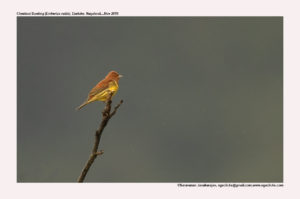
Chestnut Bunting Emberiza rutila
Etymology:
- Emberiza : Old German name Embritz for a bunting
- Rutila :Latin word for golden, red, auburn
Vernacular Names : Hindi: Lal gandam
Distribution in India: Winter visitor in North East India
Description: Size of 14–15 cm; wt. of 12–24 g. It is a medium-sized bunting with relatively short tail, longish bill and, in all plumages, yellow on underparts, unstreaked chestnut rump and almost no white on tail. The male in breeding is distinctive, with head, breast and upperparts, including upperwing-coverts as uniformly chestnut, sharply demarcated from yellow of belly. The tail feathers are uniformly brown, small area of white at tip of outer rectrices; primaries and secondaries are brown, narrow pale edges are on primaries and chestnut edges on secondaries, tertials are similar in colour to upperparts, but most of inner web is brown. The underparts below breast are lemon-yellow, some dusky streaking on flanks. The iris is dark chestnut-brown; bill is brown or bluish-horn, often paler bluish or dull pinkish-horn on most of lower mandible; legs are y pinkish, but variable. The male in non-breeding plumage is similar to breeding, with general chestnut colours concealed by pale fringes, especially on throat and superciliary area. The female in breeding has greyish-brown crown, dark lateral crownstripe with some mixed chestnut, rather indistinct buff supercilium, rest of face are dull buffish-brown, framed by brown postocular stripe which continues down and skirts ear-coverts to join narrow brown moustachial stripe, beneath which is pale buff submoustachial stripe, greyish to dusky brown malar stripe, and pale buff throat. The nape is greyish-brown with some indistinct streaks, mantle is dark-streaked greyish-brown, back to uppertail-coverts are plain rufous; lesser upperwing-coverts are rufous-brown with some olive tinge, median and greater coverts with buffy. The breast and undertail-coverts are often with some fine streaking, flanks with more prominent streaks; bare parts as on male. The female in non-breeding is similar to breeding, but with upperparts and breast browner. The Juvenile is similar to female non-breeding, but with more distinct streaks on crown and mantle, streaks on back and rump, breast is buffish with prominent streaking, flanks, belly and undertail-coverts are yellow, flanks with prominent black streaks.
Habitat: It breeds in open forest with shrubby ground cover, in coniferous forests , deciduous forest as well as in mixed forest, often on ridges of hills or slopes of mountains. In winter favours open forest, edges of woodlands and clearings, and cultivated land, from lowlands and foothills to 2500 m. During migration found also in grain fields, rice stubbles and bushes in cultivations, and open tall herb fields.
Food Habits: It eats during breeding season mainly invertebrates, such as caterpillars and other insects, as well as seeds; during migration and winter mostly seeds. It forages mainly on ground, flying up to branches of nearby trees when disturbed.
Breeding habits: They breed in Jun, very early after they arrive to the breeding territories. The nest is built from grass blades, lined with thin rootlets, concealed on ground among shrubs. They lay a clutch of 4 eggs.